|
Index...
|
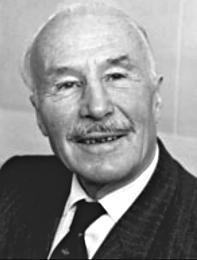
 have had a good life, a blessed life you could say. I have met many interesting people and learnt many interesting things. One of the first people I met and got to know was in the first job I had after art school. I was working for Albert Frost & Sons, a printer in Rugby, opposite the Rugby School on Dunchurch Road. I was employed in the art studio to produce artwork for the various print jobs. The company had already been producing some small flyers for a small company called Andrews Maclaren Limited, just out of Rugby in the village of Barby. They were making folding outdoor chairs and pushchairs. The Maclaren company wanted to produce some more flyers and upgrade their illustrations. The founder and owner was Owen Maclaren, who was retired but had been an aircraft designer, and specialised in undercarriages. He had designed the Spitfire's landing gear, so he was very famous.
have had a good life, a blessed life you could say. I have met many interesting people and learnt many interesting things. One of the first people I met and got to know was in the first job I had after art school. I was working for Albert Frost & Sons, a printer in Rugby, opposite the Rugby School on Dunchurch Road. I was employed in the art studio to produce artwork for the various print jobs. The company had already been producing some small flyers for a small company called Andrews Maclaren Limited, just out of Rugby in the village of Barby. They were making folding outdoor chairs and pushchairs. The Maclaren company wanted to produce some more flyers and upgrade their illustrations. The founder and owner was Owen Maclaren, who was retired but had been an aircraft designer, and specialised in undercarriages. He had designed the Spitfire's landing gear, so he was very famous.
I had started at Frost's in 1969 at the age of nineteen. I did not drive and have never owned a car. I caught the Midland Red bus to Rugby every day, so when I had to go out to Barby to meet Owen Maclaren, the managing director of Albert Frost's took me in his Austin Cambridge car. Mr. Clements, MD, looked just like Oliver Hardy, right down to the greased down centre parting. He was a lovely man, very large but very gentle and polite. We must have looked a strange sight when we turned up at the village cottage where Owen lived and worked from his stables. I still had shoulder length hair and was very skinny. We were welcomed and shown into a large dinning room with a large dark wooden table with bowls of hazelnuts still with their leaves on, and bowls of apples and pears which must have come out of their orchard.
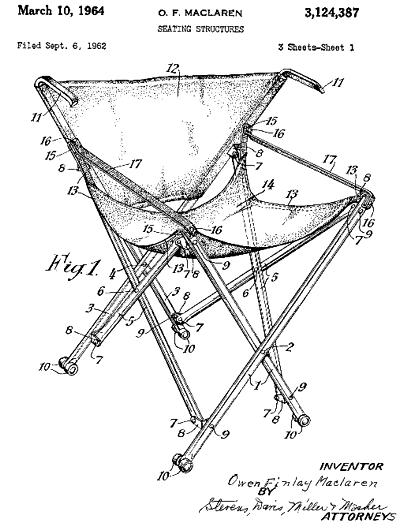
Mr. Owen Maclaren welcomed us both and we were introduced to a small, slim, older lady as Miss Andrews, Owen's partner. She was strangely dressed in a goat skin coat, goat skin boots covered in black and white patches, and had long hair. We were served tea in very large cups - the largest cups I have ever seen - more like shallow soup dishes, but they looked normal in Mr Clements' large swollen hands! We chatted for what seemed like ages, then we were taken on a tour of the large farm cottage and stables.
Dotted around the cottage were various prototypes of what Owen had been working on. He had based the first folding outdoor armchair on a design he had done for a bomber aircraft undercarriage. At various country events he had seen people trying to sit on shooting sticks - a form of walking stick which had a fold-down seat, but it only had one leg. Owen's answer was something that looked like a bundle of sticks that open up and fold out to make a four-legged chair, with arms and a back, and he called it a 'Gad about chair'.
After making various prototypes, first with wood, then aluminium tubes, moulding them to form a more curved bundle, he started making them for sale. However, they were expensive, almost hand-made, and containing a lot of components, so it had to be sold as a luxury item - he did this by selling them through the Harrods store. His first order was for about fifty, and he had them made with green and white seating cloth. Albert Frost had the word 'Harrods' stencilled on the back of each one, making them unique. We were then shown the very first 'Baby Buggy'. Almost like a 'gad about chair' but with wheels on. This had been inspired by Owen's daughter having problems getting pushchairs on and off aircraft. Owen's genius was not just putting a wheel on each leg - he put two. Like on large aircraft undercarriages, more wheels were better for strength, suspension and comfort.
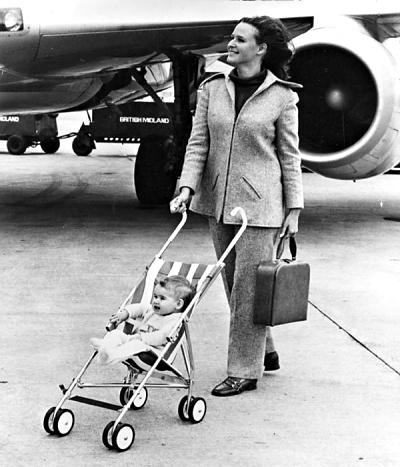
 r Clements and I had been at the Maclaren residence for nearly an hour and we still did not know what Owen wanted us to do. Then he showed us his latest invention - a larger version of the Baby Buggy. He had been asked by the Government's Health Council to create a larger buggy for children up to the age of ten. He produced a prototype that he was working on, made of square aluminium tubing for strength, which he called it the 'Buggy Major'. It had many more features, such as a hand strap around each handle, because some children can be very heavy, and when tilting the pushchair back your hand could slip off the handles. There was another strengthening feature to brace the complete chair, but this was becoming a problem as some of the struts, when closed, could trap the skin on your hands if not done with care.
r Clements and I had been at the Maclaren residence for nearly an hour and we still did not know what Owen wanted us to do. Then he showed us his latest invention - a larger version of the Baby Buggy. He had been asked by the Government's Health Council to create a larger buggy for children up to the age of ten. He produced a prototype that he was working on, made of square aluminium tubing for strength, which he called it the 'Buggy Major'. It had many more features, such as a hand strap around each handle, because some children can be very heavy, and when tilting the pushchair back your hand could slip off the handles. There was another strengthening feature to brace the complete chair, but this was becoming a problem as some of the struts, when closed, could trap the skin on your hands if not done with care.
So, I had to draw this prototype as a complete vehicle, pointing out all the safety issues as it had to got to the Ministry of Health who were going to order and supply them to clients. Gradually, features were redesigned and each part eventually became safer, especially the struts at the back where they linked together, and a foot activating device was added so that hands could be kept out of the way.
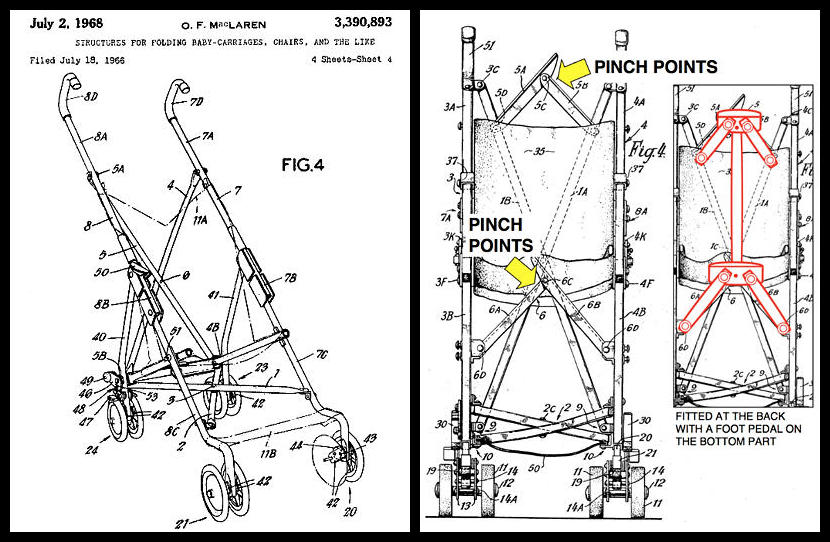
Another strange thing about the day that Mr. Clements took me to Barby was that on the way back, instead of turning at a bend in the country road, we drove into a field, the gate of which had been left open. A farmer had only just opened it to take in a tractor. Mr. Clements drove around the field and around the tractor, nodded at the farmer, and slowly left the field as though nothing had happened. We both smiled like simpletons as though it happened all the time!
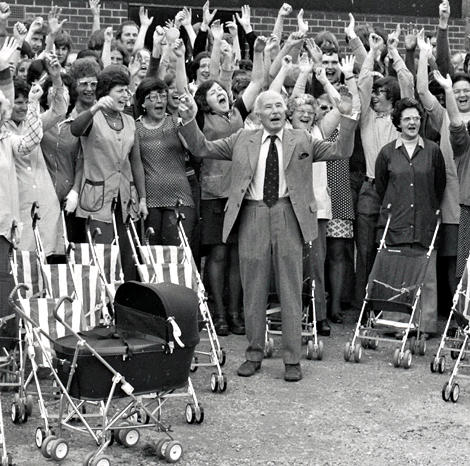
I did many drawings of all the Maclaren products, showing how they opened and folded. None of the drawings survive and I do not have any of them, but I am sure I could draw every one of them from memory - the 'Gad about chair' the 'Baby Buggy' and the 'Buggy Major'. They were all ground-breaking, and all came out of the mind of a retired old aircraft under-carriage designer. A bit like a passage from the bible - 'and they shall beat their swords into ploughshares, and their spears into pruning-hooks: nation shall not lift up sword against nation, neither shall they learn war any more.'
Owen Maclaren tried to make as many products as possible, employing most of the people from Barby and Long Buckby. A Japanese company was given the license to manufacture the products for the American market, and Owen became rich overnight. I lost contact with him when I left Albert Frost's, it was sold to the GEC and was being moved to the large GEC factory site down by Rugby Station. The old building was going to be pulled down as it was needed for road widening, and the industrial building did not fit in with the Rugby School surroundings.
I went on to work in Leamington Spa, then Coventry. I heard that Owen was a keen pilot and that he had a heart attack one day while flying his own plane. He was able to land the plane but was found dead in his cockpit. I have never been able to verify this tale but it did fit in with the spirit of Owen Finley Maclaren, M.B.E.
As a nice end-note: One day my girlfriend, now my wife, called for me at Albert Frost's studio. I was drawing a 'Baby Buggy', and not many people had seen one at that time. Sara said 'that will never catch on'. I still remind her that it is now the most produced and copied pushchair in the world.
This is your first visit to my website today, thank you!
3,157,065Website by Rob Orland © 2002 to 2024